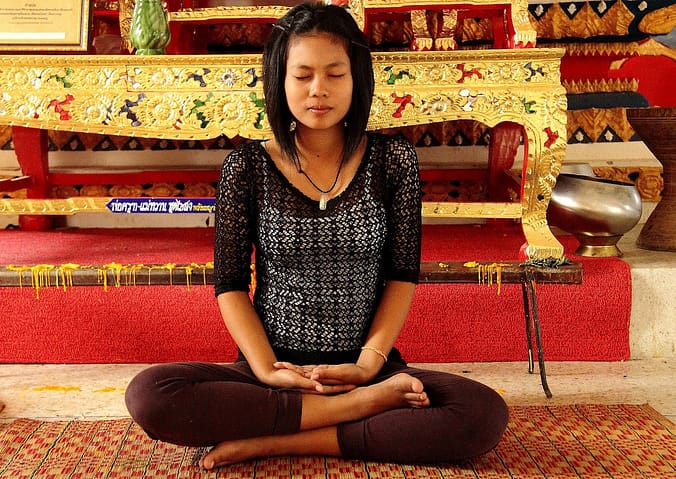What is Meditation?
“It’s what happy and successful people do,” I was told, when I first started learning about meditation and how to do it. The Dalai Lama and other Tibetan Buddhists believe that happiness is the actual goal of most people on earth. But we in the West are brought up with the idea that finding a job, buying a house, getting married and having children are what we should aim for. Yet, while aiming for these goals, and even on reaching them, quite often we feel depressed, dissatisfied, and, yes, unhappy.
Meditation has been around from time immemorial; it was first recorded in written texts from seven thousand years ago in China. While meditation has become linked mainly to Eastern cultures, it is integral to most spiritual paths, and basic to all major religions in some form or another.
Dr Ian Gawler of the Ian Gawler Foundation claimed to have been cured of cancer through meditation and dietary changes. He states that “No matter where in your life you want to see improvement, meditation can help. It does not matter what age you are, your culture or beliefs; meditation is for everyone and can provide you with great benefits, many of which have been scientifically confirmed. This simple, yet powerful mind training tool, can bring long-term improvement to your health, well-being, relationships and career.”
Modern doctors, psychologists and psychiatrists recommend “mindfulness meditation” practices as part of stress management skills. These practices are based on the same millenia old Buddhist meditation skills, often stripped of their religious connotations. Research shows that changes take place in the brains of practitioners, even after a short time utilising these methods. Nevertheless, ritual in some form or another, gives structure to these practices and encourages the formation of habits.
How to Meditate
There are many different groups offering many different meditation practices. Here is an article outlining the main different types of meditation.
Simply put, you sit with your back erect, close your eyes, focus on your breath, and practise mindfulness. It takes time and continued practice to learn how to do this easily and comfortably, without being pulled around by speedy, agitated monkey mind which refers to a person’s inability to quieten their thoughts and pacify their minds. Buddhists compare thoughts to clouds moving across the clear background of the sky.

A Simple Meditation
-
Sit or lie comfortably. You may even want to invest in a meditation chair.
-
Close your eyes.
- Make no effort to control the breath; simply breathe naturally.
-
Focus your attention on the breath and on how the body moves with each inhalation and exhalation.
- Focusing on a special sound (om) or on a source of light, such as a candle, are other useful tools.
You can use a mantra to get you in the mood for meditating, especially if you know that it has special powers, which some of them have. Om Namah Shivaya is a sacred mantra that has been used by Hindus for centuries to invoke the blessings of Lord Shiva, one of the most revered deities. Try it or look on line for others. Even better, find a guru who can pass one on to you.
A Personal Story
When our daughter was born, I asked my husband if he would give up smoking, to which he was heavily addicted. Not being a mystical sort of person, more practical, a fixer-upper and strong-willed, I was surprised when he joined a Transcendental Meditation course and was weaned or cured from nicotine addiction after two or three weeks. He didn’t even talk much about the experience, of having glimpsed people levitating, for example, that I would have loved to discuss in more detail.
A Peer-Reviewed Method of Meditating
Mark was becoming top in his field of Stuttering Research by the time our two children were in primary school. His method of treating anxiety in people who stuttered was based on peer reviewed cognitive behavioural methods rather than on anything mystical or spiritual. He used a love of classical music for relaxation, and meditation was put on the back burner. Until recently, that is. He came across this method for meditating online that is based on peer reviews and can suit anyone who wishes to meditate without having to believe in the spiritual dynamic. Now he likes to meditate in the mornings and exercises at night. He’s very motivated and disciplined and I think he’s going to benefit hugely from this new interest. Here is the link to the article he found online:





Because I have a difficult time meditating in silence, I practice Dzogchen, which is of the Tibetan tradition. There is silent meditation with Dzogchen, but I prefer the chanting. Even if I don’t notice the difference, people around me tell me they can tell when I’ve been meditating.
I followed a Tibetan practice when I was learning meditation too. I loved the beautifully worded hymns and the Buddhist icons, but it’s the meditation that has stayed with me. I’ve just started to practise yoga, which is similar. Best wishes from Copenhagan, Bradley. I’ll be back home in Sydney on the 13th October. Keep happy and well.
Anne,
Each and every day I make a peaceful pause, a time for inaction and quiet thought. I have no teacher, attend no classes nor do I read texts on the subject. I just make a conscious effort, make time and DO it (or should that be don’t DO it … anything physical that is?) I have experienced the positive impact of regular reflection, contemplation, pondering, consideration, reflection, deliberation and even prayer. I guess all these could collectively be called meditation. This “quiet time” reflection gives me a mental “breathing space” from this fast paced world, space in which to learn to become the person I really want to be.
Am I meditating?
Hello from Copenhagan, Ian. Yes, it’s all about quieting the mind, and you seem to have arrived at a place of peace. Danish people are said to be among the happiest people in the world. There are fewer and smaller cars here, not as much noise, and less carbon in the air; everyone owns at least one bicycle, and they share the p;lace with cars and pedestrians. Will get back the day after tomorrow. Keep tuned, dear friend.
I have made several attempts at meditating. I have to learn to quiet my mind. 🙁
I had to immerse myself in a Tibetan Buddhist course for westerners, in order to establish the habit of meditating. Now I can relax my mind, without having to always sit in a formal position. I’m now starting to practise Yoga, which is similar. Greetings from Copenhagan, from where I’ll be returning home to Sydney on the 13th October. Looking forward to catching up.